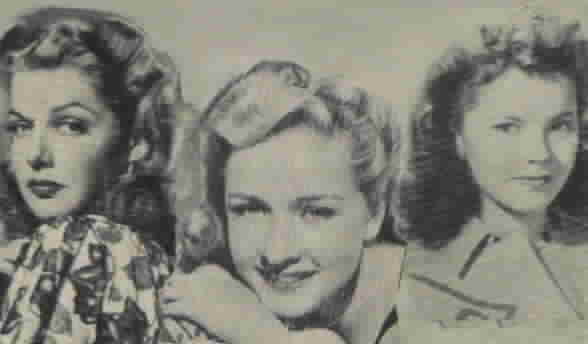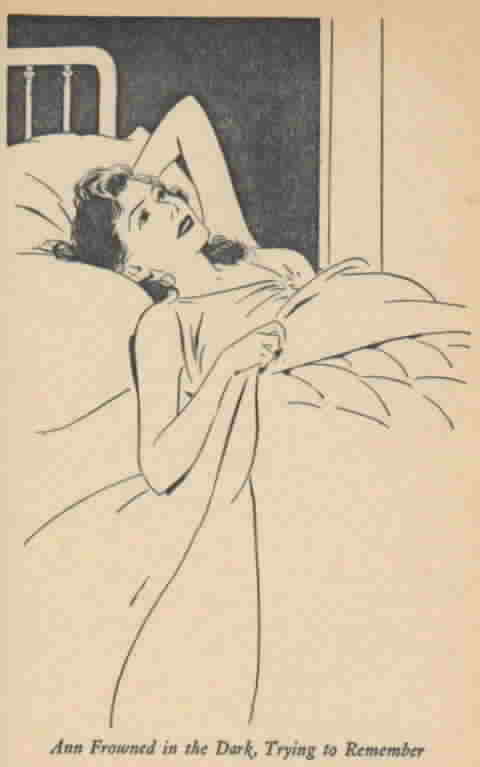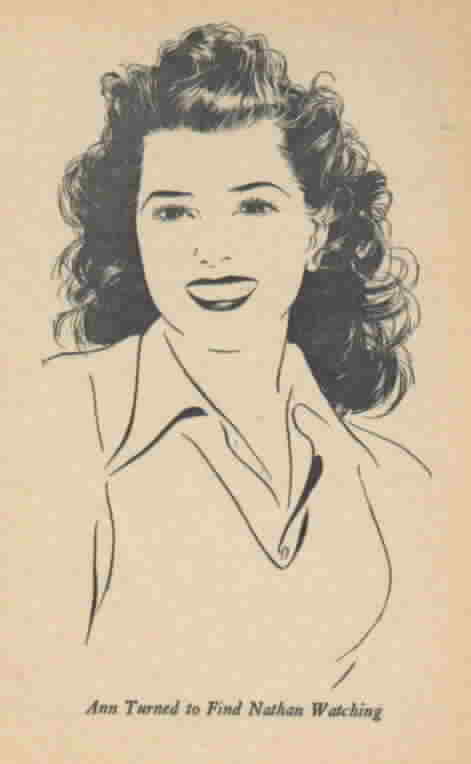 |
Whitman Movie Star Authorized Editions |
|
|
||
The Whitman Publishing Company of Racine, Wisconsin is known best for its authorized editions. These editions were inspired by various media such as radio, film, and comic strips. Each authorized edition featured personalities from the various selected media, and these personalities took part in stories that ranged from mystery and adventure to humor. The specific focus of this section is the nineteen authorized editions from the 1940s that have an actor or actress named in the title and pictured on the book's dust jacket. All of these editions are part of the Whitman 2300 series. |
|
|
| While the Whitman Authorized Editions are not a series, they are a collection of similar stories with similar themes. The books are a reflection of the 1940s. In several books, young women live with their single mothers, paralleling the fact that most men were away fighting in the war. Additionally, the villains often are people who are working against the United States government. In one book, the bombing of Pearl Harbor occurs shortly after the plot begins, and the entire story is centered around spies working against the United States. Finally, in several stories, the heroine states that she is "doing her part" by visiting and entertaining the troops. | |||
|
Brief Summaries
Dust Jacket Gallery The books that were published in the middle of the set are the most common, and both the earlier and the later books are more scarce. The books published in 1943 and 1944 are by far the most common titles. The 1947 titles are quite scarce. The mid-range titles can nearly always be found very inexpensively, either with or without dust jackets. Expect to pay significantly more for the 1947 titles. |
|||
|
|
|||
The Illustrations |
|||
 |
The movie star connection is exploited in the internal illustrations of the Whitman Authorized Editions. In most of the illustrations, the heroine appears to be posing, even when it is not appropriate for the illustrated scene. The heroine is always glamorous and well-dressed and is sometimes shown wearing a flimsy nightgown. Pictured here are two illustrations from Ann Rutherford and the Key to Nightmare Hall. In both pictures, Ann appears to be posing. At the left, Ann is supposed to be frowning thoughtfully, and at the right, Ann should be nervous. |
 |
|
|
|
|||
The Authors |
|||
|
14 of the 19 titles were written by Kathryn Heisenfelt, and all of Heisenfelt's stories read like parodies of series books. Heisenfelt's characters nearly always encounter one or more people who are stricken by fear that is superstitious. The heroine is usually fearful as well, with the difference being that the heroine is able to control her fear enough not to make a complete fool out of herself. Every event in the story has a mysterious importance, and normal, everyday sounds, such as a shutting door or a cat's meow, are often taken to be extremely scary. The mystery usually turns out to be a fairly insignificant mystery, and in some cases would not have been a mystery had everyone communicated with each other. In short, Heisenfelt's books tend to be overly-dramatic. The entire plot of each Heisenfelt book usually occurs in a very short period of time, often in fewer than 24 hours.
The remaining authors each contributed one title to the set. Elizabeth Beecher wrote Van Johnson: The Luckiest Guy in the World. Roy J. Snell's contribution, Jane Withers and the Phantom Violin is a rehashing of his 1934 novel, The Phantom Violin. Eleanor Packer's Jane Withers and the Hidden Room and Matilda Bailey's Dorothy Lamour and the Haunted Lighthouse are both excellent stories that read much like the original Nancy Drew and Dana Girls books. Ginger Rogers and the Riddle of the Scarlet Cloak was written by Lela E. Rogers, Ginger's mother. Lela Rogers' story is more emotional and personal than the other stories in this set. While the fictitious Ginger helps to bring an enemy agent to justice, she falls in love, meets her father for the first time, and comes to an understanding with her mother, Mary. |
|||
|
|
|||
The Heroine's Identity |
||
|
The stories fall into two different groups. In the first group, the heroine is identified as a famous actress: Bonita Granville and the Mystery of Star Island, by Kathryn Heisenfelt, 1942 Betty Grable and the House with the Iron Shutters, by Kathryn Heisenfelt, 1943 Ann Sheridan and the Sign of the Sphinx, by Kathryn Heisenfelt, 1943 Jane Withers and the Swamp Wizard, by Kathryn Heisenfelt, 1944 Judy Garland and the Hoodoo Costume, by Kathryn Heisenfelt, 1945 Shirley Temple and the Spirit of Dragonwood, by Kathryn Heisenfelt, 1945 Shirley Temple and the Screaming Specter, by Kathryn Heisenfelt, 1946 Gene Tierney and the Invisible Wedding Gift, by Kathryn Heisenfelt, 1947
While the heroine is identified as a famous actress, the stories are entirely fictitious and center around a mystery that convenient appears while the heroine is briefly visiting a dear friend. In some of these stories, many of the other characters fail to recognize the actress in spite of her openness about her identity! Occasionally, the actress hopes not to be recognized and tries to alter her appearance. The most bizarre and amusing instance occurs when Bonita Granville pretends not to be Bonita Granville but insists that people call her Bonita since everyone thinks she resembles Bonita Granville! Bonita's story results in Bonita receiving a few odd looks from her new acquaintances.
In the second group of stories, the heroine has the same name and appearance as the famous actress but has no connection to the famous actress:
In the above books, it is as though the famous actress has stepped into an alternate reality in which she is an ordinary person. Two titles, Ann Rutherford and the Key to Nightmare Hall and Jane Withers and the Phantom Violin, have been placed in this second group because it is very unclear whether the main character is famous. The statements made in the texts are so vague and ambiguous that it makes more sense to believe that the character is not famous.
|
||
|
|
||
Story Quality
The stories in the Whitman Authorized Editions range from great to bad. Below, the stories are classified as above average, average, and below average based on how much this reader enjoyed reading them. |
||
|
Above Average
Deanna Durbin and the Feather of Flame |
Average
Deanna Durbin and the Adventure of Blue Valley |
Below Average
Bonita Granville and the Mystery of Star Island |
Significant Thoughts: Jane Withers and the Hidden Room occurs at an exclusive boarding school. There are two unexpected plot twists during the story that will keep the reader guessing how it will end. This book is reminiscent of the Dana Girls series due to the boarding school setting. Dorothy Lamour and the Haunted Lighthouse reads much like the early Nancy Drew books. Dorothy begins work as a secretary to a lighthouse keeper but hears strange sounds at night. She discovers a hidden room and a secret passageway and single-handedly solves a jewel heist. Ginger Rogers and the Riddle of the Scarlet Cloak has all of the desired elements of mystery and adventure as well as a romance. Ginger's difficulty in her relationship with her mother is also explored. This book and the two mentioned above are unquestionably the best books in the set. Ann Rutherford and the Key to Nightmare Hall is excellent once the reader gets past the stupidity of Ann and Bop of not informing their host that they are not prospective heirs as he believes. Judy Garland and the Hoodoo Costume has a scene in which Judy is forced by a spirit swindler to perform as a spirit for his clients. Judy uses her best acting skills in her performance, and the result is a most hilarious scene. In Bonita Granville and the Mystery of Star Island, Bonita Granville's inner voice warns her of danger on Star Island. The reader does not feel Bonita's fear since there is absolutely nothing odd or mysterious except for her inner voice. Bonita's inner voice is a constant distraction throughout the story, and the reader cannot help but feel that Bonita needs immediate psychiatric help. Jane Withers and the Phantom Violin is a horribly confusing book to read, as the author switches randomly back and forth between the different girls in their separate adventures. The reader must suspend belief when Jane effortlessly catches a wolf by the tail with a fishing line and when a charging moose is quieted by a violin and then scared into retreat by a scream. The girls also have a pet loon, and Jeanne spends most of the book with her gypsy friends and their pet dancing bear. Most of the book's events are unrelated and random, and it is difficult to make sense of most of the story. Jane Withers and the Swamp Wizard reads as an average story in the set, but the ending is bizarre and unsettling. This reader was left with a creepy and repulsed feeling and has no desire to ever read the story again. If you don't mind having the ending completely spoiled and are curious, then click here to find out why. |
|
|
|
|
This section was inspired by the article, Whitman 1940s Movie Star Books for Girls by Betsy Caprio Hedburg, which appeared in the August 2000 issue of The Whispered Watchword newsletter. Hedburg successfully argues why these books should be collected by series book enthusiasts. For more information on Whitman books, refer to Whitman Juvenile Books: Reference and Value Guide by David and Virginia Brown, 1997. |
|
|
|
|
|
Whitman Publishing Company Information Back to Main Page |